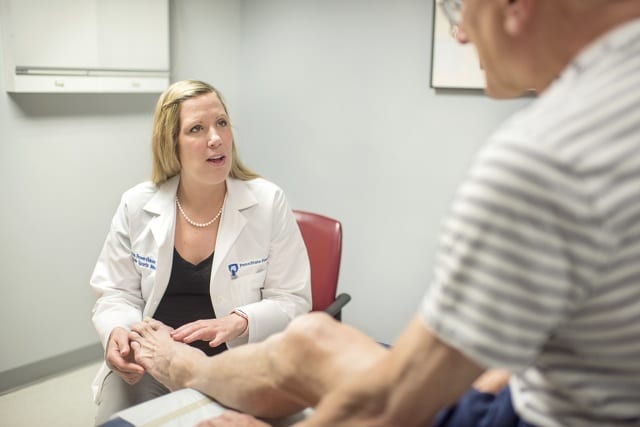Our feet are our bodies’ shock absorbers, bearing all of our weight with every step, day after day and year after year. Many older people suffer from foot problems as a result of this wear and tear, as well as specific medical conditions. Easy routine care can help prevent or minimize many of these problems.
Proper foot care is important for people of all ages, but becomes vital for older individuals for several reasons:
- Aging skin is thinner and less elastic – beginning as early as the 50s – making injuries more likely and healing more difficult.
- Arthritis leads to pain in the feet and ankles.
- Osteoporosis can weaken foot bones, especially in women.
- Problems with vision or flexibility can make it difficult for older people to spot cuts or sores on the feet before they become dangerous.
- One in four Americans age 65 and older has diabetes, which can cause nerve damage and poor circulation in the extremities.
Older individuals with diabetic neuropathy may lose feeling in their feet and not notice minor sores or ulcers. Poor circulation makes it difficult for the body to heal these ulcers, which can lead to serious infections and amputation.
Anyone over the age of 65 should undergo an annual foot exam, and quarterly exams are often indicated for older diabetics. The medical professional will look for skin lesions, check the pulse in each foot, and safely cut toenails. A podiatrist (a foot and ankle specialist) may prescribe compression stockings or special shoes. Some insurance plans cover part or all of the cost of these accessories when prescribed by a physician.
Daily foot care
Seniors should check each foot every day for swelling, cuts, splinters, changes in skin color, or other minor problems. If bending to see the bottom of the foot is difficult, sit on a chair, place a hand mirror on the floor and hold the foot above the mirror. Call for an immediate medical appointment as soon as a change is noticed.
Making other simple measures part of daily life can help prevent foot problems for people of all ages:
- Run a hand inside shoes before putting them on and after taking them off to locate rough or sharp spots. If the damage can’t be repaired, it’s time to buy new shoes.
- Wear socks with shoes to protect against blisters. Socks should be seamless and not too tight.
- Don’t go barefoot, either in the house or outdoors. In addition to providing proper support, shoes protect the feet from unexpected substances, such as animal waste, that could cause an infection through contact with a small break in the skin.
- Make sure shoes are the correct size. Shoes that are the wrong size can restrict circulation, cause blisters, or lead to a fall. Shoe size can change over the years, so ask a knowledgeable store clerk to help determine the correct size and type of shoe.
- Wash feet every day and dry thoroughly (especially between the toes) before putting on shoes and socks.
- Keep nails properly trimmed. Ask for help, if needed, from a family member, home health aide, or podiatrist.
- Don’t cross the legs, which can limit blood flow to the feet when sitting.
- Ask a medical professional to treat calluses, corns, or warts. Attempting removal at home can cause cuts and sores.
Pay attention to foot pain
Unfortunately, many seniors take foot pain in stride as a “normal” part of aging. Because their feet hurt, they wear slippers rather than supportive shoes, leading to a shuffling gait and increased risk of falling.
Instead of giving in to foot pain, take care of the feet every day. Consider athletic shoes that offer good support for the 26 bones and 33 joints that make up each foot. See a podiatrist when symptoms are impacting daily life. The result can be a more active and healthier life for many years to come.
Christina Rowe-Bauer, DPM, is a podiatrist with Penn State Sports Medicine at 1850 E. Park Avenue, Suite 112, State College. She treats patients of any age. For more information, call (814) 865-3566.



